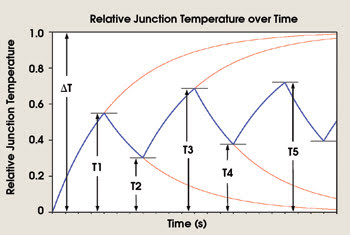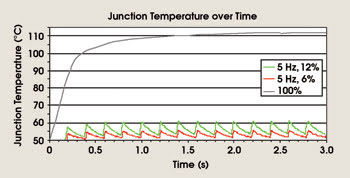Higher current capabilities of power LEDs enable strobed lighting for vision systems.
Matt Pinter, Smart Vision Lights, and Christos Sarakinos, Future Lighting Solutions
Smart cameras, at a reduced price, have continued to increase capabilities for machine vision applications, but lighting has not kept pace. There is hope, however, if lighting designers take advantage of performance and packaging breakthroughs.
For power LEDs, the relationship between the forward current and the light output is direct, assuming constant temperature. As DC forward current is increased, light output increases.
The first power LED introduced in 1999 by Philips Lumileds had a nominal forward current of 0.35 A and maximum DC forward current of 0.38 A, leaving little room to overdrive the LED for increased light output. Since then, light output has increased significantly, and with the introduction of higher-current packages, red power LEDs now can withstand up to 2.2 A.
Even when DC current increases at the same rate, the relative increase in light output of power LEDs varies from manufacturer to manufacturer and occurs at various rates. Thus, care must be taken to select the appropriate power LED.
The power dissipated through the LED is a product of the forward current, the forward voltage and quantum efficiency. Thus, increasing the drive current also increases the power dissipated. Along with ambient temperature and system thermal resistance, dissipated power is one of the main factors contributing to increased junction temperature. (The junction is the semiconductor die within the power LED that is responsible for light production.)
The light output of a power LED decreases as its junction temperature increases. For some technologies, such as those responsible for producing blue light, this decrease is negligible. For others, such as those responsible for producing red light, it can be significant.
If the junction temperature surpasses the maximum on the product data sheet, the integrity of the silicone encapsulate surrounding the die deteriorates, and the LED fails catastrophically. In addition, an elevated junction temperature causes irreversible degradation over time. So, although greater light output can be achieved by driving power LEDs harder, there is a thermal cost. The increased heat must be properly managed.
Thermal management
From a thermal standpoint, power LEDs differ from other sources. Unlike traditional LEDs, they have separate electrical and thermal paths. And unlike conventional lighting, they do not radiate heat forward, but instead conduct it through the slug to the underside of the device. From there, the heat generally moves to the board, to the heat sink and, finally, to the air.
When using high-power LEDs in high-current applications such as vision system lighting, a large, bulky heat sink or thermoelectric cooler is needed to maintain a reasonable junction temperature. Although heat sinks made from aluminum and copper dissipate heat quickly and efficiently, they are costly to manufacture and difficult to design. Nevertheless, to ensure proper operation and to prevent power LED failure, many lighting manufacturers are designing such costly, elaborate systems to ensure necessary heat dissipation capabilities.
Strobing for machine vision
However, there is a way to lessen the heat dissipation needs in machine vision applications. More than 90 percent of machine vision applications can strobe the light used for the inspection. A strobe is an extremely short burst or pulse of light at a higher than normal intensity, synchronized with the image acquisition in a camera. The majority of cameras are set up to use strobed light sources. If strobed, lighting can be designed with far less heat sinking, resulting in simpler designs and tangible cost savings.
When a power LED is turned on, the power dissipates, and the thermal characteristics of the system components determine the thermal response time constants that, in turn, govern the temperature rise and fall times. The junction temperature rises sharply when the LED is on and decreases sharply when it turns off (Figure 1). Hence, strobing the LEDs gives the junction temperature time to drop, minimizing the heat sinking needed.

Figure 1. Strobing of power LEDs gives the junction temperature time to decrease. The red lines show the steady-state response of a power LED that is in constant DC operation.
Frequency and duty cycle can control the junction temperature of machine vision lighting systems. A low duty cycle (typically between 6 and 12 percent) is very forgiving. Thus, in a pulsed system with a low duty cycle, the junction temperature is affected heavily by frequency, and so frequency determines the amount of heat sinking that is required.
The calculations that predict junction temperature by taking into account all the factors involved are complicated and time-consuming. The effect of frequency, in particular, is not straightforward. Fortunately, there is thermal simulation software with built-in models of power LEDs and with transient simulation capabilities.
Strobing of power LEDs allows a lower junction temperature with increased light; conversely, if the light-output level is acceptable, strobing the power LEDs allows greatly reduced heat sinking (Figure 2). As a result, the size and cost of heat sinking will be reduced. This technique finally will allow camera lighting to achieve up to a 200 percent increase in light at reduced cost, letting it catch up with smart cameras.

Figure 2. The junction temperature of a red Luxeon III emitter at 2.2 A at constant forward current, strobed at a duty cycle of 12 percent and of 6 percent, is compared.
Meet the authors
Matt Pinter is a design engineer at Smart Vision Lights in Muskegon, Mich.; e-mail: [email protected].
Christos Sarakinos is a regional technical manager at Future Lighting Solutions in Montreal; e-mail: christos.saraki [email protected].